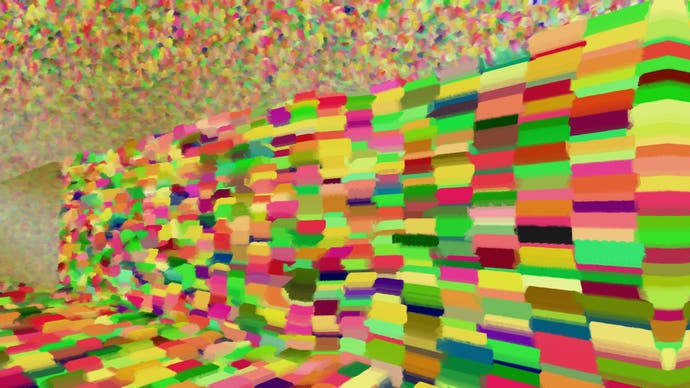The Catacombs of Solaris Revisited is the most indoors I've felt since lockdown began
Vanishing point.
Like you, I have been surrounded by the same four walls for approximately one billion years now, entombed in a two-bedroom sarcophagus, hemorrhaging rent to an invisible overlord to maintain homeostasis in a world stood still. I'm convinced that, when I am asleep, these walls creep inwards by a few imperceptible millimetres, and that soon I'll have to slowly squeeze through narrow hallways to get around, like my flat is perpetually loading the next area, until one Tuesday afternoon I am finally crushed to death.
The Catacombs of Solaris Revisited is incredibly indoors. It's the most indoors I've felt since lockdown began. It's a free-roaming kaleidoscope, a perspective-shifting maze with no exit and no entrance. As you explore, the shapes of corridors and corners become momentarily apparent, their edges made visible by the patterned walls skewing and stretching as you move around. When you stop or turn, the maze changes. Sections that were once open space become flat textures projected onto solid walls, like Wile E Coyote's paintings of tunnels, or 3D chalk artworks on the pavement.
There's no light or shadow to offer your eyes any clues as to the catacombs' true shape, just the angles where the different textures seem to line up, and the illusory vanishing points suggested by the barely legible edges of rooms. There is no true shape. The credulous cubic inch of your brain responsible for creating mental maps is bamboozled every few steps you take, giving this visual toy the vibe of an unpredictable, psychedelic nightmare.
Once you grow desensitised to raw, undulating colourscapes, you can import your own custom image to use as the pattern of the walls, floors and ceilings, allowing you to freely wander around inside an increasingly distorted memory of your trip to Whitstable Bay. Your photo is stretched and diced into an unrecognisable smear of pixels the deeper into the maze you venture, before pinging back to its original resolution when you round a corner, ready to be blended up all over again. Seeing your pictures of the outside mutilated by the forms of the inside feels suffocating, like being stuck inside your own skull.

There was a moment during last month's Super Bowl half-time show when, as part of his act, pop sensation the Weeknd became trapped inside a glass tesseract of light and mirrors somewhere deep inside the bowels of the Raymond James Stadium. The panicked Canadian songster searched in vain for a way out of the shimmering labyrinth, staggering wide-eyed around blind corners and along dazzling catwalks. Disorientated and afraid, the Weeknd repeatedly came face to face with reflections of his reflections, until those very reflections came to life and began to attack him, and then dance with him.
The Catacombs of Solaris Revisited is an impression of that moment, the terrifying sensation of being lost inside an infinite cage that won't stop changing shape. There are no reflections to dance with or treasures to discover, beyond the simple sensory joy of experiencing a lot of different colours and shapes happening at the same time. It is a sometimes nauseating and claustrophobic experience, but it's occasionally very beautiful. A Windows Media Player visualiser you can crawl around inside, but can never leave.


